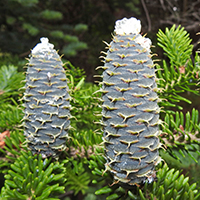What balsam fir looks like
Size and shape
- Large tree.
- Reaches 30 metres high.
- Tall and narrow and tapers to a skinny point at the top.
Needles
- Needles 2 to 4 centimetres long.
- Dark and shiny green with two white bands underneath.
Bark
- Greyish in colour.
- Covered in sap blisters.
Cones
- Buds range from red and purple to bluish green in colour.
- Flowers develop into compact cones.
Where balsam fir is found
Balsam fir grows in a variety of climates and temperatures and is found across Ontario.
What you need to know to grow balsam fir
- Moisture: grows in all soil moisture levels.
- Shade: grows in sun or shade.
- Soil: grows in a variety of soils.
- Cautions:
- Balsam fir roots do not grow very deep so these trees can blow down during extremely high winds. Plant balsam fir in a sheltered area or away from your house.
- When balsam fir grows in a group of trees, branches at the bottom of the tree die and dry out. As long as they get sunlight, the lower branches stay green all the way to the ground.
Benefits and uses of balsam fir
Wildlife benefits
Bark is consumed by porcupine, squirrels cache cones and several types of birds will feed on the seeds and buds. The tree provides cover for small rodents, birds and large mammals.
Commercial uses
Balsam fir is commonly used for pulp and plywood. It is also used as an essential oil in aromatherapy.
Fun facts about balsam fir
- Balsam firs are often used as Christmas trees because they smell nice, and keep their needles for a long time after being cut down.
Updated: January 10, 2024
Published: July 18, 2014



